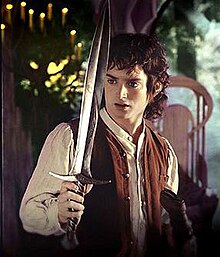This is an old revision of this page, as edited by JJMC89 bot III (talk | contribs) at 19:48, 7 December 2019 (Moving Category:Magic objects to Category:Magical objects per Misplaced Pages:Categories for discussion/Speedy). The present address (URL) is a permanent link to this revision, which may differ significantly from the current revision.
Revision as of 19:48, 7 December 2019 by JJMC89 bot III (talk | contribs) (Moving Category:Magic objects to Category:Magical objects per Misplaced Pages:Categories for discussion/Speedy)(diff) ← Previous revision | Latest revision (diff) | Newer revision → (diff)
| The topic of this article may not meet Misplaced Pages's general notability guideline. Please help to demonstrate the notability of the topic by citing reliable secondary sources that are independent of the topic and provide significant coverage of it beyond a mere trivial mention. If notability cannot be shown, the article is likely to be merged, redirected, or deleted. Find sources: "Sting" Middle-earth – news · newspapers · books · scholar · JSTOR (November 2019) (Learn how and when to remove this message) |
| It has been suggested that this article be merged into Middle-earth objects. (Discuss) Proposed since November 2019. |
| Sting | |
|---|---|
| Lord of the Rings franchise element | |
 Elijah Wood as Frodo, holding Sting, in The Lord of the Rings film trilogy Elijah Wood as Frodo, holding Sting, in The Lord of the Rings film trilogy | |
| First appearance |
|
| Created by | J. R. R. Tolkien |
| Genre | Fantasy |
| In-universe information | |
| Type | Magical dagger |
| Function | Weapon |
| Traits and abilities | Ornate dagger which glows in the presence of orcs or goblins, and is supernaturally strong |
| Affiliation | |
Sting is a fictional artefact from J. R. R. Tolkien's fantasy universe of Middle-earth. In the story, it is a magical Elvish knife or dagger presumably forged in Gondolin in the First Age.
In The Hobbit (1937), hobbit Bilbo Baggins finds the blade in a troll-hoard, along with the swords Glamdring and Orcrist. Although it is only a dagger by the standard of Men or Elves, it serves as a sword for the diminutive Bilbo. He uses it to fight off the giant spiders in Mirkwood, and names the blade after the talking spiders refer to it as his "sting". Gollum is afraid of Sting, which aids Bilbo in his confrontation with Gollum under the Misty Mountains. Bilbo gives Sting to his nephew Frodo Baggins in The Fellowship of the Ring (1954). When Frodo is betrayed at the pass of Cirith Ungol, Samwise Gamgee takes the blade to prevent it from falling into enemy hands, but later returns it to Frodo. In The Return of the King (1955), Frodo gives Sting and all of his other possessions to Sam before Frodo departs for the Undying Lands.
Sting has the magical ability to detect orcs or goblins nearby, glowing blue in their presence, as it did when the Fellowship encountered orcs in the mines of Moria. Tolkien establishes this as a common property of First Age Elf blades, particularly those forged in Gondolin. Sting is also exceptionally sharp. Bilbo manages to thrust it without effort deep into a wooden beam at Rivendell. Frodo also wounds a troll in Moria, after Boromir notches his own sword with his attempt. Sam uses Sting to cut through the giant spider Shelob's strong webs with ease, and also wound the spider, driving it away from the paralyzed Frodo.
Bilbo blades in Europe
In real Europe, a bilbo blade (sometimes spelled "bilbow") was an exceptionally fine blade, named after the city of Bilbao where such blades were made. It is possible that Bilbo's name and his acquisition of this sharp blade were connected in the author's mind.
Adaptations
In Peter Jackson's The Lord of the Rings and The Hobbit film adaptations, Sting is depicted as vaguely leaf-shaped, with gentle curving edges. Engraved on the blade and cross-guard are letters in Sindarin that read phonetically, Maegnas aen estar nin dagnir in yngyl im. Translated into English, they read, "Maegnas is my name, I am the spider's bane." According to the Appendix of The Silmarillion, the element maeg in Sindarin means "sharp" or "piercing". The film version of Sting is 23 inches (580 mm) long (24 while in scabbard) and 3 inches (76 mm) wide at the hilt. Its scabbard is made of brown leather and reinforced with metal. In The Hobbit book, Sting does not bear the inscription.
References
- Gee, Henry (2004). The Science of Middle-Earth. Cold Spring Press. p. 236. ISBN 978-1-59360-023-5.
- John Rateliff (2010), "The Hobbitonian Anthology of Articles on JRR Tolkien and His Legendarium", Tolkien Studies, 7: 330–335, doi:10.1353/tks.0.0066, ISSN 1547-3163,
I would suggest that it's far more likely Bilbo gains Sting because Tolkien became aware of the 'bilbow blade = sword' entry in the OED than that the character was given the name with the idea of his becoming a sword-wielder already in mind. However, as there was a Count Frodo and a Bishop Bilbo in the Frankish Kingdom of the middle ages as well as another noble named Fredegar it is more likely that these Hobbit names were mined from Frankish history.
- Smith, Chris (2003). The Lord of the Rings Weapons and Warfare. London: HarperCollins. ISBN 0-00-717201-X.